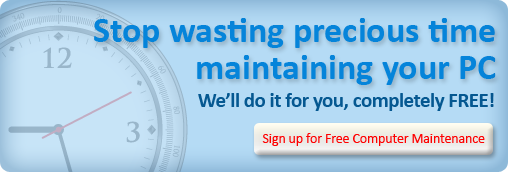 Any number of problems can develop over time on a PC, and in order to keep your computer running like new, you’ll need to be able to perform some basic maintenance.
Any number of problems can develop over time on a PC, and in order to keep your computer running like new, you’ll need to be able to perform some basic maintenance.
There are many tools available for diagnosing and fixing issues, and some come included with Windows so that you can use and stop problems before they start.
When used regularly, these three suggested tools for maintenance will keep your computer running at peak efficiency.
Defragment Your Disk
As more and more files are added to your computer, space can become an issue. Eventually you can fill up an entire hard drive, but even when there is still space available there can be problems storing files on a computer due to fragmentation. Fragmentation occurs when your computer doesn’t have enough contiguous space to store a file in one spot, so it stores the file in the free space between other files already saved on the system.
Imagine you have a book that you wanted to put on a shelf, but there’s not enough space between any of the books already on the shelf to simply set the book down. Instead of moving the books already on the shelf to make space for the new book, you take apart the new book and put sections of it in the spaces between the old books. This quick solution makes it so you don’t have to move anything that’s already been placed on the shelf, but makes it difficult to find and read the disassembled book later.
This is essentially how your computer automatically deals with files that don’t easily fit on the hard drive. By running the Disk Defragmenter, your computer can rearrange files in order to access files more quickly and increase your overall computer speed. To run the Disk Defragmenter, follow the steps below:
- Click the Start button.
- Go to All Programs.
- Go to Accessories.
- Go to System Tools.
- Click on Disk Defragmenter.
- Select the drive you want to defragment, then click the Defragment Disk button.
This process may take some time if it hasn’t been run in a while, so let the program take some time to perform the task.
Run Disk Cleanup
In addition to files you are saving and using on your computer, there are many stored that are unnecessary and can slow down your computer. Temporary Internet files, old system files, and even deleted files in the Recycle Bin can affect the performance of your computer. Disk Cleanup can remove these files quickly and easily. Just follow the steps below:
- Click the Start button.
- Go to All Programs.
- Go to Accessories.
- Go to System Tools.
- Click on Disk Cleanup.
- Disk Cleanup will determine how much space you can free up on your hard drive, then click the check boxes next to each type of file you want to remove.
- Click the Clean up system files button.
This process may also take some time to run, so give it some time to take care of the maintenance.
Run CHKDSK
Fragmented and unnecessary files aren’t the only problems you might encounter with your PC. Issues with bad sectors, directory errors, and and number of disk problems can lead to serious trouble over time. The CHKDSK utility performs maintenance on the hard drive and repairs basic errors. CHKDSK can be run by following these steps:
- Click the Start button.
- Click Run and type cmd then press Enter.
- Type chkdsk then press Enter.
- If you have files on the hard disk open, you will receive the following message: Chkdsk cannot run because the volume is in use by another process. Would you like to schedule this volume to be checked the next time the system restarts? (Y/N)
- Type y then press Enter.
The next time you restart your computer, it will run CHKDSK and check from errors and attempt to repair them.
These tools are vital to maintaining your computer over time, and all three are features that can be run automatically for free with Free Computer Maintenance, so be sure to sign up to be notified when it is released!